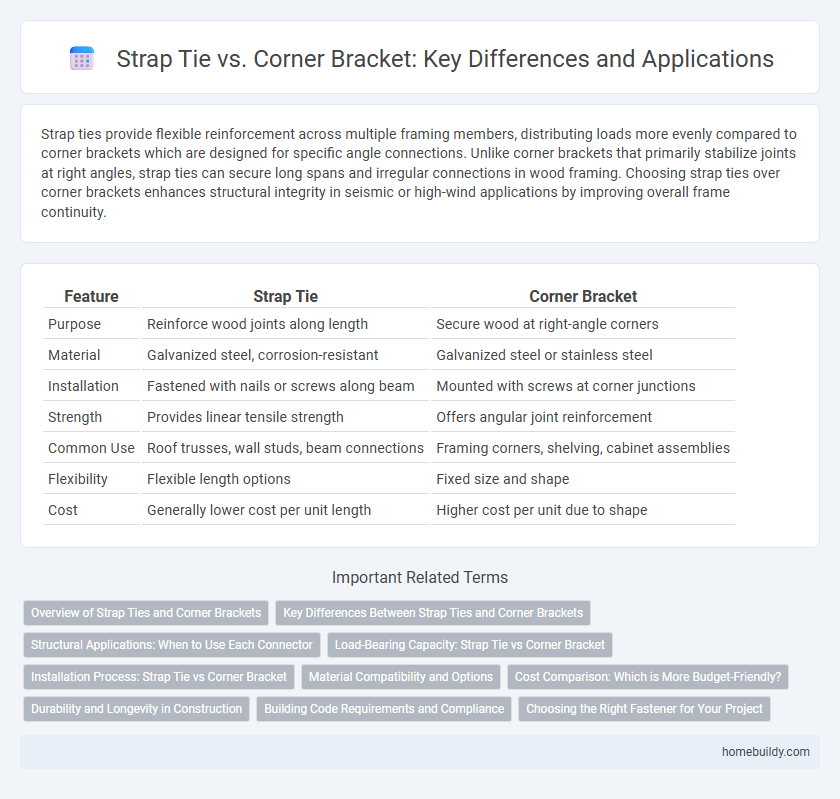Strap ties provide flexible reinforcement across multiple framing members, distributing loads more evenly compared to corner brackets which are designed for specific angle connections. Unlike corner brackets that primarily stabilize joints at right angles, strap ties can secure long spans and irregular connections in wood framing. Choosing strap ties over corner brackets enhances structural integrity in seismic or high-wind applications by improving overall frame continuity.
Table of Comparison
| Feature | Strap Tie | Corner Bracket |
|---|---|---|
| Purpose | Reinforce wood joints along length | Secure wood at right-angle corners |
| Material | Galvanized steel, corrosion-resistant | Galvanized steel or stainless steel |
| Installation | Fastened with nails or screws along beam | Mounted with screws at corner junctions |
| Strength | Provides linear tensile strength | Offers angular joint reinforcement |
| Common Use | Roof trusses, wall studs, beam connections | Framing corners, shelving, cabinet assemblies |
| Flexibility | Flexible length options | Fixed size and shape |
| Cost | Generally lower cost per unit length | Higher cost per unit due to shape |
Overview of Strap Ties and Corner Brackets
Strap ties are long, flat metal connectors designed to reinforce joints along wooden beams and prevent structural movement. Corner brackets are L-shaped metal fittings used primarily to strengthen right-angle joints in framing and cabinetry. While strap ties provide linear support over extended surfaces, corner brackets focus on securing perpendicular connections.
Key Differences Between Strap Ties and Corner Brackets
Strap ties offer extended surface area for distributing loads along beams and joists, whereas corner brackets concentrate forces at joint intersections for enhanced corner stability. Strap ties are typically used for reinforcing linear connections in wood framing, while corner brackets provide rigid support at the junction of perpendicular members. Material thickness, load capacity, and installation method also differ, with strap ties often requiring more fasteners over a broader span compared to the compact design of corner brackets.
Structural Applications: When to Use Each Connector
Strap ties provide linear reinforcement along beams and joists, making them ideal for securing long, continuous connections in wood framing and preventing lateral movement. Corner brackets offer rigid 90-degree support at joints and are best used where two members intersect, such as wall corners or rafter to top plate connections, enhancing angular stability. Selecting between strap ties and corner brackets depends on structural requirements: use strap ties for tensile strength across spans and corner brackets for compressive or shear load support at right-angle joints.
Load-Bearing Capacity: Strap Tie vs Corner Bracket
Strap ties offer superior load-bearing capacity compared to corner brackets due to their extended surface area and ability to distribute tension forces effectively across wood joints. Corner brackets often concentrate stress at fixed points, making them less ideal for heavy load applications in structural framing. Engineers and builders prefer strap ties for enhanced stability and durability in load-intensive connections such as roof trusses and wall assemblies.
Installation Process: Strap Tie vs Corner Bracket
Strap ties offer a straightforward installation process, typically requiring fewer fasteners and less precise alignment compared to corner brackets. Corner brackets demand more meticulous positioning to ensure secure connections at joint angles, often involving additional drilling or fastening steps. The simpler installation of strap ties can reduce labor time and minimize errors, making them a preferred choice for quick and effective structural reinforcement.
Material Compatibility and Options
Strap ties typically come in galvanized steel, stainless steel, or zinc-coated options, ensuring strong resistance against corrosion and suitability for both wood and metal framing materials. Corner brackets, often made from heavy-gauge steel or aluminum, provide rigid support primarily for wood connections but may require additional treatment to prevent rust in outdoor applications. Choosing between strap ties and corner brackets depends on the specific material compatibility and environmental exposure requirements of the construction project.
Cost Comparison: Which is More Budget-Friendly?
Strap ties generally offer a more budget-friendly solution compared to corner brackets due to their simpler design and lower material costs. Corner brackets tend to be priced higher because of their heavier gauge steel and more intricate manufacturing process. For projects prioritizing cost efficiency, strap ties provide effective structural support at a reduced expense without compromising durability.
Durability and Longevity in Construction
Strap ties offer superior durability in construction by providing continuous support along the length of joints, reducing stress concentration compared to corner brackets. Made from galvanized steel, strap ties resist corrosion and deformation, enhancing longevity in various environmental conditions. Their flexibility in application ensures structural integrity over time, outperforming corner brackets that may weaken at fixed points.
Building Code Requirements and Compliance
Strap ties and corner brackets both play crucial roles in meeting building code requirements for structural reinforcement, but strap ties offer superior compliance due to their ability to provide continuous load paths essential in seismic and wind-resistant construction. Building codes like the International Residential Code (IRC) often specify the use of strap ties for their proven effectiveness in resisting uplift and lateral forces, ensuring a more reliable connection between framing members. Corner brackets, while useful for localized reinforcement, may not meet the same rigorous performance standards required for full code compliance in critical structural applications.
Choosing the Right Fastener for Your Project
Strap ties provide superior load distribution and flexibility for securing long spans and irregular angles, making them ideal for framing repairs and structural reinforcement. Corner brackets offer rigid, right-angle connections, best suited for precise joint stabilization and preventing lateral movement. Selecting the right fastener depends on project requirements, where strap ties excel in strength and adaptability, while corner brackets provide critical support for corner assemblies.
Strap tie vs corner bracket Infographic

 homebuildy.com
homebuildy.com